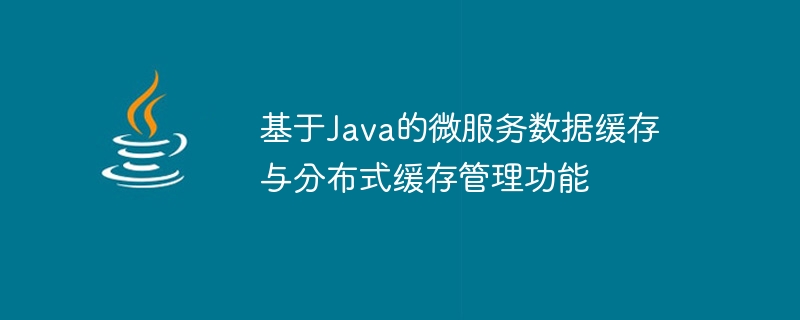Home >Java >javaTutorial >Java-based microservice data caching and distributed cache management functions
Java-based microservice data caching and distributed cache management functions
- WBOYWBOYWBOYWBOYWBOYWBOYWBOYWBOYWBOYWBOYWBOYWBOYWBOriginal
- 2023-08-10 12:25:431293browse

Java-based microservice data caching and distributed cache management functions
Microservice architecture is attracting more and more attention in modern software development. With the rapid development of microservices, data caching and distributed cache management functions have become critical. In this article, we will introduce how to use Java to write data cache in microservices and implement distributed cache management functions.
1. Introduction
Data caching is a technology that stores commonly used or hot data in fast-access storage media. It can significantly improve your application's performance and response time. However, in a microservice architecture, the management of data cache becomes more complex because it involves data synchronization and consistency guarantees among multiple service nodes.
2. Build the environment
Before we start writing code, we need to build a suitable environment. First, we need to install a Java development environment. Java 8 or above is recommended. Secondly, we need to choose a suitable distributed cache management tool. This article will use Redis as an example tool.
3. Implement data caching
First, we need to use Java to implement the data caching function in microservices. To simplify the code, we will use Spring Boot to create a simple microservice application. The following is a simple sample code:
import org.springframework.cache.annotation.Cacheable;
import org.springframework.stereotype.Service;
@Service
public class ProductServiceImpl implements ProductService {
@Override
@Cacheable(value = "products", key = "#id")
public Product getProductById(Long id) {
// 在这里实现从数据库或其他数据源获取Product对象的逻辑
}
}In the above code, we use the Spring framework’s cache annotation @Cacheable. This annotation tells Spring to check whether a record with the key id already exists in the cache before executing the method. If it exists, return the data directly from the cache, otherwise, execute the logic in the method and store the result in the cache.
4. Distributed cache management
Next, we need to implement distributed cache management. The reason for using Redis as a distributed caching tool is its high performance, high scalability and rich functionality.
- Configuring Redis dependencies
First, we need to introduce the Redis dependencies in the pom.xml file of the project:
<dependency>
<groupId>org.springframework.boot</groupId>
<artifactId>spring-boot-starter-data-redis</artifactId>
</dependency>- Configure Redis connection information
Configure Redis connection information in the application.properties file:
spring.redis.host=127.0.0.1 spring.redis.port=6379 spring.redis.password=
- Enable cache management
The method to enable the cache management function is very simple. Just add the @EnableCaching annotation to the Spring Boot main class:
@SpringBootApplication
@EnableCaching
public class Application {
public static void main(String[] args) {
SpringApplication.run(Application.class, args);
}
}- Distributed Cache management example
import org.springframework.cache.Cache;
import org.springframework.cache.CacheManager;
import org.springframework.data.redis.cache.RedisCacheManager;
import org.springframework.data.redis.core.RedisOperations;
import org.springframework.data.redis.core.RedisTemplate;
import org.springframework.stereotype.Component;
@Component
public class DistributedCacheManagerImpl implements DistributedCacheManager {
private final CacheManager cacheManager;
public DistributedCacheManagerImpl(final RedisTemplate<String, Object> redisTemplate) {
this.cacheManager = new RedisCacheManager(redisTemplate);
}
@Override
public void put(String key, Object value) {
Cache cache = cacheManager.getCache("distributedCache");
cache.put(key, value);
}
@Override
public Object get(String key) {
Cache cache = cacheManager.getCache("distributedCache");
return cache.get(key);
}
@Override
public void remove(String key) {
Cache cache = cacheManager.getCache("distributedCache");
cache.evict(key);
}
}In the above code, we created a DistributedCacheManager interface and used Redis to implement its specific functions. By injecting RedisTemplate to operate the Redis database, the distributed cache management function is implemented.
5. Summary
This article introduces how to implement data caching and distributed cache management functions in microservices based on Java. By using the Spring framework's cache annotations and Redis as a distributed cache tool, we can easily implement data caching and ensure the consistency and high availability of cached data. This is very important to improve the performance and response time of microservice applications. Through the sample code in this article, readers can easily use these functions in their projects and conduct further expansion and optimization.
The above is the detailed content of Java-based microservice data caching and distributed cache management functions. For more information, please follow other related articles on the PHP Chinese website!

